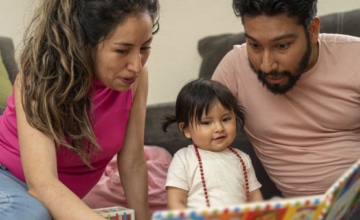This article provides ideas for ways to handle these stressful situations in a way that helps parents maintain control and respond effectively.
Jacob, almost 3 years old, has thrown himself on the floor of the grocery store screaming that he must have one more chocolate, just one more! Sound familiar? If so, you are not alone. Most parents of young children live in terror of their little one losing it in public. It’s hard to avoid feeling judged and ashamed of out-of-control behavior, as if it is evidence of total incompetence as a parent, surely a result of your indulgence which has inevitably created a spoiled child. And for parents who don’t particularly care what others think, it can just be exhausting and frustrating when you are trying to get something done. This experience naturally puts parents themselves in an emotionally charged place, feeling embarrassed and often angry at their child for putting them in this nasty situation.
So, what can you do in these moments to reduce the stress both for yourself and your child—with the added benefit of feeling competent and effective instead of weak and mortified?
Don’t let the onlookers get to you.
Ideally, just tune them out. Most are likely feeling your pain, having been there themselves, and aren’t judging. And for those feeling some guilty pleasure that it’s not them in the hot seat, ignoring is still a good strategy so you can stay focused on coming up with a productive response to helping your child cope.
Or, kill them with kindness.
If a bystander makes some really helpful (not!) comment (“I think he’s hungry”…”His diaper may be dirty”), avoid being reactive. You have nothing to be defensive about. Instead, try: “It is so nice that you want to help. I really appreciate it. But I’m all good. Learning that he can’t get everything he wants is a hard lesson for a little guy, right?” This is a nice way to send some important messages: “I am in control, and I am being a really good parent by setting appropriate limits and helping my child learn to cope with life’s disappointments.” This can be a particularly good strategy when it is your mother, or mother-in-law, or another close friend or family member who is trying to help.
Stay calm.
If you are anxious and upset, your child is more likely to be anxious and upset. If you are calm and composed, she is likely to pull herself together more quickly. So while your emotional reaction is completely understandable, it is not strategic to come on strong, because it tends to escalate rather than calm your child. When she is falling apart, she needs you to be her rock. Best to take a few deep breaths and remind yourself that, if you lose it too, it will likely make the situation at hand more stressful and challenging. (And, for those parents who can’t let go of what others are thinking—you don’t want to give any of those judgy onlookers any ammunition.)
Validate your child’s feelings.
“I know you are very angry that I am not giving you any more chocolate.” Validating feelings is not the same as validating behavior. Feelings aren’t the problem—they just are. It’s what kids (and parents) do with their feelings that can be problematic. That’s why one of your most important jobs is to help your child learn to manage these strong, difficult emotions in ways that are pro-social. But that takes time and practice. And it starts with validation—which helps children feel understood—and is the first step in helping them identify and then manage these emotions.
Provide choices that *you can implement*.
This might mean offering your child a choice of another, acceptable food—perhaps something that is a little special but healthy, such as yogurt raisins. Some parents don’t want to offer a substitute at all. That is a personal decision. Even when offering the alternative, your child may flat-out reject it and intensify the tantrum to show you just how lame he thinks this other option is. In that case, you calmly say, “You are really upset about not getting what you want. It is my job to keep you safe so I am going to put you in the grocery cart. You will be okay.” And then you follow through with as much calm as you can muster and ignore all his efforts to get you to react. Divert yourself by talking about what you see in the grocery aisles. You might ask him if he can find and point to his favorite cereal on the shelf. This lets him know you are going to ignore his outburst, but you are not ignoring him, and that you can handle his upset and will be a “safe base” for him.
Most important is to try not to allow your worry about bystanders’ opinions and judgments to drive your behavior in these situations. Many parents report that they end up giving in to their child in order to get her to behave—to avoid the embarrassment or hassle—even though they don’t think that’s best for their child. But you have nothing to be embarrassed about; and when you give in, your child is cleverly putting 2 and 2 together: “Mommy or Daddy will pretty much give me anything to get me to quiet down when we’re anywhere but home!” Children having breakdowns when they don’t get their way is a normal part of growing up. When you respond calmly and empathically, and set clear limits that you can enforce, you send both your child and the onlookers the message that you’re all good—calm and in control.




